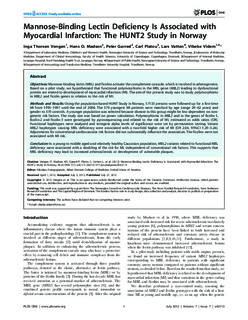Mannose-Binding Lectin Deficiency Is Associated with Myocardial Infarction: The HUNT2 Study in Norway
Vengen, Inga Thorsen; Madsen, Hans O; Garred, Peter; Platou, Carl Geoffrey Parrinder; Vatten, Lars Johan; Videm, Vibeke
Journal article, Peer reviewed
Permanent lenke
http://hdl.handle.net/11250/2365823Utgivelsesdato
2012Metadata
Vis full innførselSamlinger
Sammendrag
Objectives:
Mannose-binding lectin (MBL) and ficolins activate the complement cascade, which is involved in atherogenesis. Based on a pilot study, we hypothesized that functional polymorphisms in the MBL gene (MBL2) leading to dysfunctional protein are related to development of myocardial infarction (MI). The aim of the present study was to study polymorphisms in MBL2 and ficolin genes in relation to the risk of MI.
Methods and Results:
Using the population-based HUNT Study in Norway, 57133 persons were followed up for a first-time MI from 1995–1997 until the end of 2008. The 370 youngest MI patients were matched by age (range 29–62 years) and gender to 370 controls. A younger population was selected because disease in this group might be less dependent on non-genetic risk factors. The study size was based on power calculation. Polymorphisms in MBL2 and in the genes of ficolin-1, ficolin-2 and ficolin-3 were genotyped by pyrosequencing and related to the risk of MI, estimated as odds ratios (OR). Functional haplotypes were analyzed and stringent alpha levels of significance were set by permutation testing. Variant MBL2 haplotypes causing MBL deficiency were associated with a two-fold higher risk of MI (OR 2.04, 95%CI 1.29–3.24). Adjustments for conventional cardiovascular risk factors did not substantially influence the association. The ficolins were not associated with MI risk.
Conclusion:
In a young to middle aged and relatively healthy Caucasian population, MBL2 variants related to functional MBL deficiency were associated with a doubling of the risk for MI, independent of conventional risk factors. This supports that MBL deficiency may lead to increased atherosclerosis or development of vulnerable plaques.
